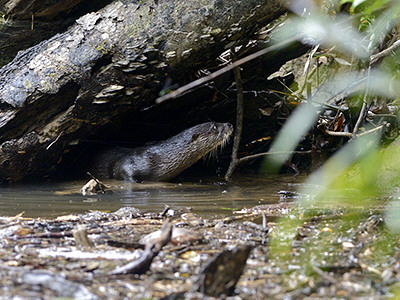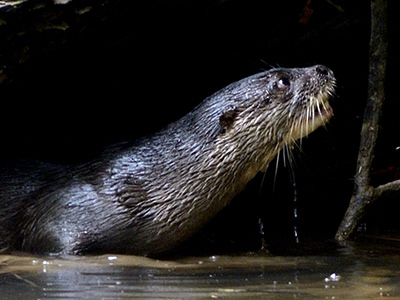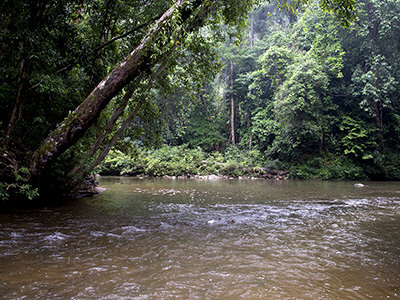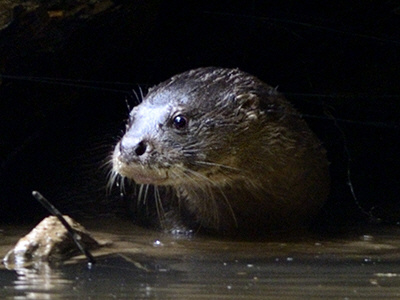
Fig 1

Fig 2

Fig 3

Fig 4

Fig 5
|
Order : CARNIVORA
Family : Mustelidae
Species : Lutra sumatrana
Head-body length : 60-80 cm
Tail length : 37-50 cm
Weight : 7-8 kg
The Hairy-nosed Otter
Lutra sumatrana is perhaps the least studied and rarest of the
world's 13 species of otter. It is believed to be at risk of extinction due
to historically heavy hunting pressure for its pelt and meat, especially in
the northern part of its range (Vietnam, Cambodia) and loss of habitat
throughout its range.
Historical records suggest it once occurred in a variety of habitats including
coastal regions, large rivers, peat swamp forests in lowland areas, and
rocky streams in hilly or montane areas up to 1800 metres elevation.
In Peninsular Malaysia there are only two formally documented records of the species
since the 1960's, both roadkills in areas near lowland peat swamp forest. The images
presented here, taken by the author in May and September 2013 in the protected area of
Taman Negara, comprise the first published records of the species in Peninsular
Malaysia since the 1990's and the first records for Taman Negara. The discovery of the
Hairy-nosed Otter in the
national park is encouraging for the survival of the species as a whole.
The rivers in Taman Negara are pristine lowland rivers which pass through
undisturbed dipterocarp forest : such habitats were once widespread
in Peninsular Malaysia but are now much reduced as a result of deforestation and conversion of land to other uses.
Both lone individuals
shown here were observed exploring river banks : they did not appear to be searching for fish or other aquatic
fauna, rather these otters were showing great interest in the river
banks themselves.
Based on studies in Thailand and Vietnam this species appears to consume a
variety of prey : in addition to fish (probably its main food source in some
areas) it may also eat water snakes, frogs, lizards, insects, crabs, small
mammals etc.
The external characteristics which distinguish this species are an extremely
sleek, sinuous body form, a relatively flattened head, somewhat rough fur, a
creamy-white chin, throat and lips. The fur along the side of the
neck and upper torso is medium brown, which contrasts with the pale fur of
the throat and the dark fur on the rest of the body. The rhinarium (the
moist, exposed part of the nose) is covered in short hair. The tail is
flattened and oval in cross-section, and the feet are fully webbed.
Wright et al (2008) includes the following countries in its historical range
: Myanmar, Thailand, Cambodia, Vietnam, Peninsular Malaysia, Sumatra and
Borneo. Some researchers fear that its current distribution is now highly
localized and fragmented in these territories.
Fig 1 : Searching a river bank beneath a fallen tree.
Fig 2 : Side view, showing a sleek, slender profile with rather coarse,
grizzled fur.
Fig 3 : A typical pristine
lowland river in Taman Negara, in the heart of the Malay Peninsula : this
particular stretch appears to be favoured by
the Hairy-nosed Otter.
Fig 4 : Close-up showing the relatively flattened head, creamy-white
neck, throat and lips.
Fig 5 : This lone individual briefly emerged into full view on a fallen tree
trunk.
References :
Baker, N. (2013). New Records of Hairy-Nosed Otter (Lutra sumatrana)
in Peninsular Malaysia. IUCN Otter Spec. Group Bull.
30 (2): 112 - 118. [pdf]
Francis, C.M. 2019. A Field Guide to the Mammals of South-east Asia. Second
Edition. New Holland. 416 pp.
Lekagul, B., McNeely, J., 1977. Mammals of Thailand. Association for the
Conservation of Wildlife, Thailand. 758 pp.
Payne, J., Francis, C.M., 1998. A Field Guide to the Mammals of
Borneo. The Sabah Society.
Wright, LC, Olsson, A and Kanchanasaka, B (2008). A Working Review of the
Hairy-Nosed Otter (Lutra sumatrana). IUCN Otter Spec. Group Bull.
25 (1): 38 - 59
Links :
IUCN Otter
Specialist Group
International Otter Survival
Fund |